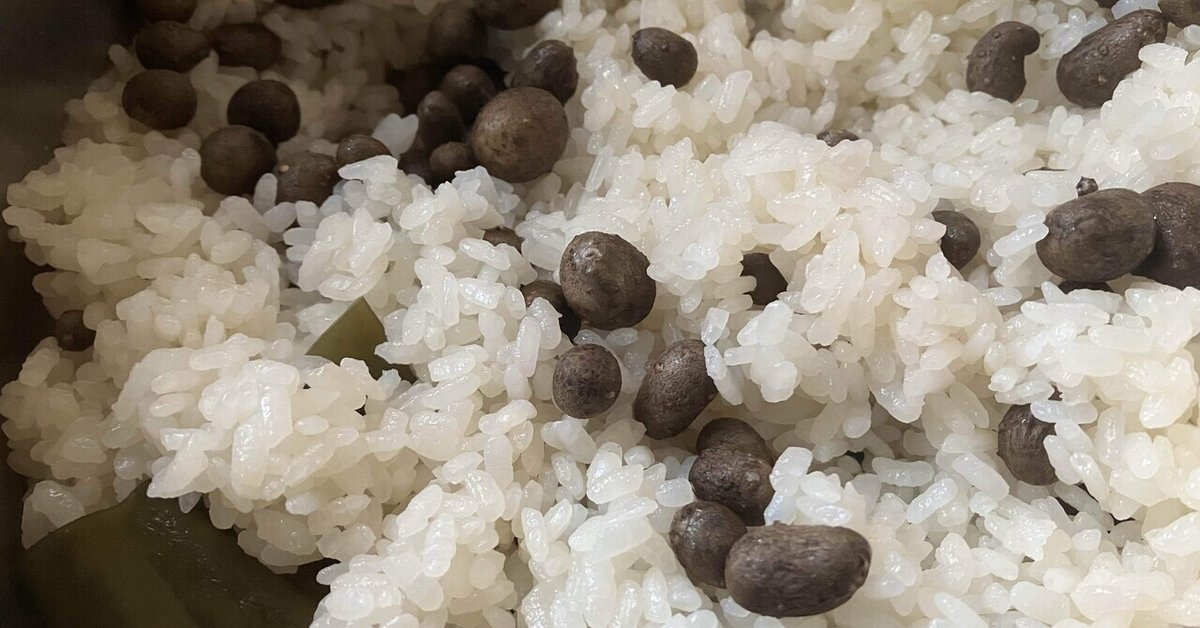
張る野蔓正体見たりむかご飯 The identity of the mysterious wild vine has been discovered, and it is now used as an ingredient in "mukago rice" おまかせ小品集 Chef's choice dishes collection
深夜食堂(ドラマの深夜食堂よりずっと前のお話)」でお出しした料理の小品集。材料がある限り何でも出してました。ほとんど即興だったので何百種類も作りましたが、お客様のエピソードを思い出せるものを少しづつ再現します(差し支えある話は多少脚色しています)。
A collection of small dishes served on "Midnight Diner" (a story that took place long before the TV drama "Midnight Diner"). We served anything as long as we had the ingredients. Since it was mostly improvisation, we made hundreds of dishes, but we will recreate little by little the ones that remind us of our customers' episodes (we have dramatized some of the more inappropriate stories).
おまかせの時間
The inspiration for the recipe
僕の立っていた深夜バーの入口がある小道に、ちょっとした植え込みがある。飲食店雑居ビルの一角で、まだ鉄筋コンクリートのビルが全盛でない時代に作られた、小さな憩いのスペースだったようだ。
ある時、お客さんが葉っぱを持ち込んできて、「これ何かな?そこの植え込みに生えてきた蔓植物なんだけど?」と僕に判定を求めてきた。見ると「ヤマノイモ」の葉のようだった。その植え込みには雑草しか生えていなかったので、どこからか種が運ばれてきたらしかった。英語では「yum」と総称されるナガイモやヤマノイモ属の葉であることは確かなのだけど、葉っぱ一枚なので、自信がない。「多分、ヤマノイモとかナガイモの類だと思いますよ」と答えておいた。「食べられるの?」と、興味津々でその女性のお客さんが応じた。適当なことを言うのも嫌なので、「葉っぱだけだと断定できないので、夏が終わるまで少し待ちましょうよ。誰も草刈りしなければ、食べられる種類なら、むかごが出てくるはずだから」とその時は答えておいた。翌日、件の植え込みを見ると、確かに蔓が茂っている。近寄って観察すると、葉が「対生(葉が向かい合って付いている)」している。むかごを作らないそっくりな「トコロ」という同属の蔓植物は「互生(葉が互い違いに付いている)なので、多分「自然薯」の類だ。ただ、そこまで専門家ではないので、がっかりさせるのは避けたいので、黙っておいた。そのお客さんはよっぽど興味を持ったらしく、毎週デジカメで成長記録を撮って僕に見せてくれた。
夏休みが終わって、その彼女が嬉しそうに「むかご」を手に握りしめてやってきた。どうやら、当たりだったようだ。彼女曰く「これって、むかご飯になるんでしょ。全部穫ってくるから、むかご飯作ってよ!」。「まあ、みんな雑草しか生えない植え込みと思って通り過ぎてるんだから、拝借しちゃいましょう!でも、怪しまれないように、人気のない時間にこっそり収穫してきてくださいね」と僕は答えた。翌日、早速彼女が収穫してきたむかごは丼一杯の量があり、その場の皆んなにご馳走して、一足早く秋の香りの炊き立てご飯を楽しんだ。余りはおにぎりにしてあげて、彼女が全部持ち帰ったのだった。
There was a small plants bed corner in the alleyway leading to the entrance of the late-night bar where I was standing. It was in a corner of a building housing multiple restaurants and cafes, and it seemed to have been a small space for relaxation built in an era before reinforced concrete buildings were in their heyday.
One day, a customer brought in a leaf and asked me to identify it, saying, "What is this? It's a vine that grew in that plantsbed." When I looked, it looked like a "Dioscorea japonica" leaf. There were only weeds growing in the plantsbed, so it seemed like the seeds had been brought there from somewhere. I was sure that it was a Chinese yam or a vine of the Dioscorea genus, collectively known as "yum" in English, but since it was just a leaf, I wasn't quite sure. "I think it's probably a Chinese yam or a vine of the Dioscorea genus." I answered. "Is it edible?" the female customer replied, curious. I didn't want to give a random answer, so I answered, "I can't be sure that it's just a leaf, so let's wait a little until the summer is over. If no one mows the grass, if it's an edible species, the bulbils should come out." The next day, I looked at the plantsbed in question and sure enough, the vines were lush. When I looked closer, I saw that the leaves were "opposite (leaves facing each other)." A similar vine in the same genus called "Tokoro" which does not produce bulbils has alternate leaves (leaves arranged alternately), so it is probably a type of "wild yam". However, I am not that much of an expert, and did not want to disappoint him, so I kept quiet. The customer seemed quite interested, as he took pictures of its growth every week with his digital camera and showed them to me.
After the summer vacation ended, she came back with a happy look on her face, clutching some "mukago(bulbils)" in her hands. It seemed like she had won. She said, "These can be used for mukago rice, right? I'll pick them all up, so please make mukago rice for me!" "Well, everyone passes by thinking it's just a patch of weeds, so let's get some! But, but, please make sure you pick them secretly at a quiet time so you don't arouse suspicion," I replied. The next day, she quickly harvested a bowl full of mukago, which I treated everyone there to and they enjoyed some freshly cooked rice with the scent of autumn. I made rice balls out of the leftovers, and she took them all home with her.
ヤマノイモ科ヤマノイモ属で食用になる種類は大まかに言って三種類ある。記録にはないが日本に元から自生していたと思われる「自然薯」、中国から平安時代に渡ってきたいわゆる「ナガイモ」、そして沖縄で栽培されている東南アジア原産の「ダイショ」の3つだ。ナガイモは野生化しているので、この手の葉っぱで対生しているのを見つけたら、多分自然薯かナガイモだと思う。葉の互生するトコロはむかごを作らない。同じ互生の葉を持つ「カシュウイモ」も暖かい地方だと混ざって生えてくる。こっちはむかごを作るけど、大きくごつごつしていて、齧るとかなり苦いので、すぐ分かる(アフリカでは苦味の少ない同種は食用になっている。日本のものも、トチの実などと同じく灰汁抜きをちゃんとすれば可食だけど、普通は食べない)。
むかごを種だと思っている人が多いけど、実は違う。茎が肥大して芋の 組織になったもので、いわゆるクローン(細胞複製)だ。むかごを作るヤマノイモの仲間は、地下茎とむかごと種の三通りの繁殖戦略を持っている。大抵の群生する株は全部雄花だけだったり、雌花だけだったり、滅多に種は作らない。地下茎とむかごだけの繁殖だと、雑種はできないはずだけど、葉の形などにバリエーションがあって、何らかのタイミングで種を付けて自然交雑することもあるようだ。実際「ナガイモ」の亜種には、丸い芋を作る「ツクネイモ」、手のひらの様な芋を作る「イチョウイモ(手芋)」があるし、皮が白いものや茶色のものがあったりする。
ヤマノイモは、ツクネイモやイチョウイモのことだったり、自然薯を指していたりして、一貫した呼び方が無くて、ちょっややこしい。
近場に、陽当たりのあまり良くない崖沿いや壁沿いの空き地があったら、観察してみてほしい。結構な都会でも、思わぬところにこの仲間が自生しているのを見つけることができる。
There are roughly three types of edible species in the Dioscoreaceae family, Dioscorea genus. They are the "Jinenjo" (japanese natural yam), which is thought to have always grown in Japan, although there is no record of it; the so-called "Nagaimo" (chinese yam), which was introduced from China during the Heian period; and the "daisho" (purple yam), which is native to Southeast Asia and cultivated in Okinawa. Nagaimo has become wild, so if you find one with leaves like this growing in pairs, it is probably a Jinenjo or Nagaimo. The alternate leaves do not produce bulbils. In warm regions, "Kashuimo" (air potato), which has the same alternate leaves, also grows mixed together. This one produces bulbils, but they are large and rough, and are quite bitter when bitten, so you can tell right away (in Africa, the same species with less bitterness is edible. The Japanese one is also edible if you properly remove the astringency, like horse chestnuts, but it is not usually eaten).
Many people think that bulbils are seeds, but in fact they are not. They are stems that have swelled and become tuber tissue, and are what we call clones (cell duplication). The yams that produce bulbils have three different reproduction strategies: rhizomes, bulbils, and seeds. Most colonies have only male flowers or only female flowers, and they rarely produce seeds. If they reproduced only through rhizomes and bulbils, hybrids would not be possible, but there are variations in leaf shape, and it seems that they sometimes produce seeds and naturally cross-breed at some point. In fact, there are subspecies of "nagaimo" (Japanese yam), such as "tsukuneimo" (a type of yam) that produces round tubers and "ichouimo" (a type of yam) that produces palm-shaped tubers, and there are also tubers with white or brown skin.
Dioscorea japonica can refer to Tsukuneimo, Ginkgo yams, or even wild yams, and there is no consistent name for it, which can be a little confusing.
If you have a vacant lot near you that is along a cliff or wall that doesn't get much sun, take a look. Even in large cities, you can find this plant growing wild in unexpected places.
バーの近くの件のヤマノイモが生えてきたのはその年だけで、多分誰かが芋ごと掘り起こしてしまったのかもしれない。翌年は雑草の植え込みに戻ってしまっていた。その後、誰かが植えたのか、毎年ミントが生えてくる様になった。その年に近場のバーでミント山盛りモヒートの大盤振る舞いがあったのは、偶然ではなかったかもしれない。
ここ数年僕のアパートの塀のところにも、毎年ヤマノイモが生い茂るので、むかご飯を作った。
The yam near the bar only grew that year, and maybe someone dug it up. The next year it was back to being a patch of weeds. After that, someone must have planted mint, as it started growing every year. It may not have been a coincidence that a nearby bar served up a mountain of mint-topped mojitos that year.
For the past few years, yam has grown thickly along the fence of my apartment every year, so I've started making mukago rice with it.
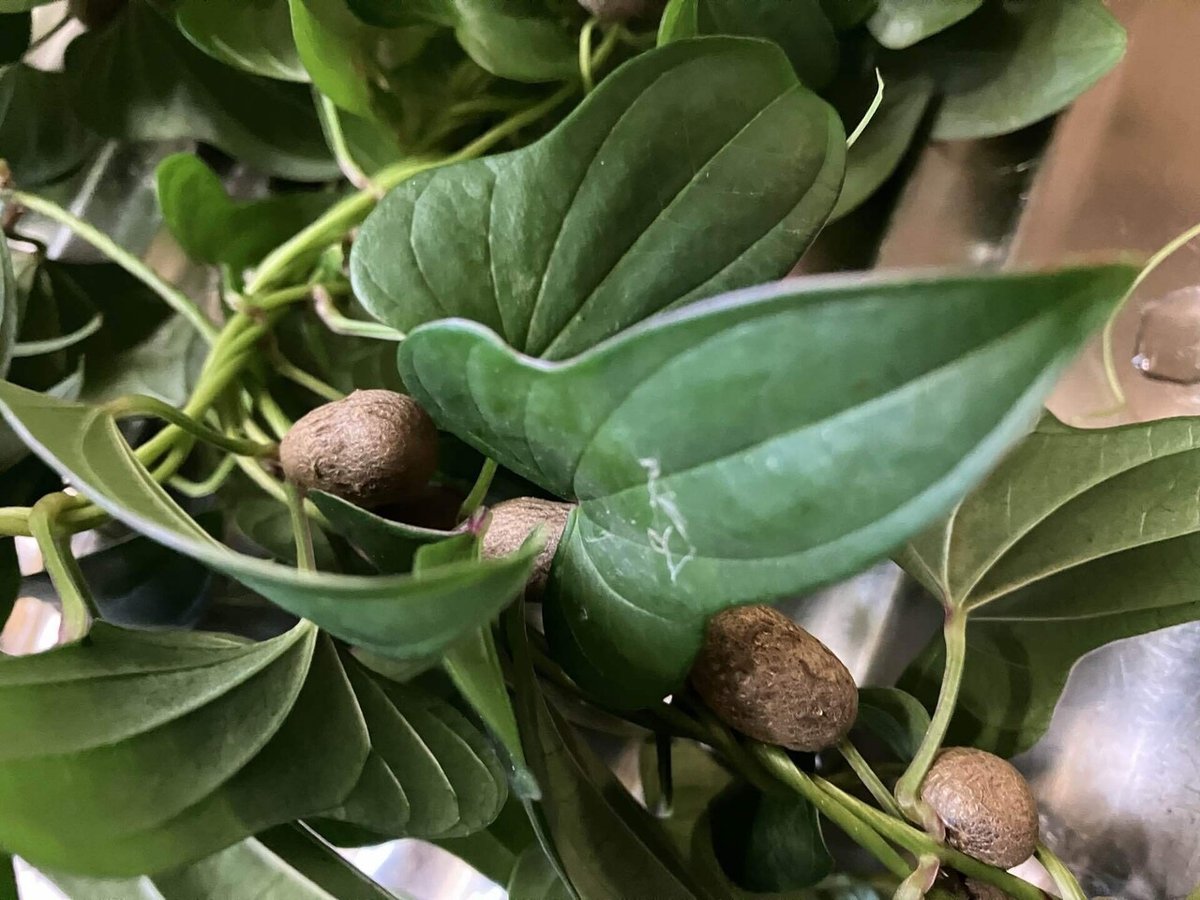
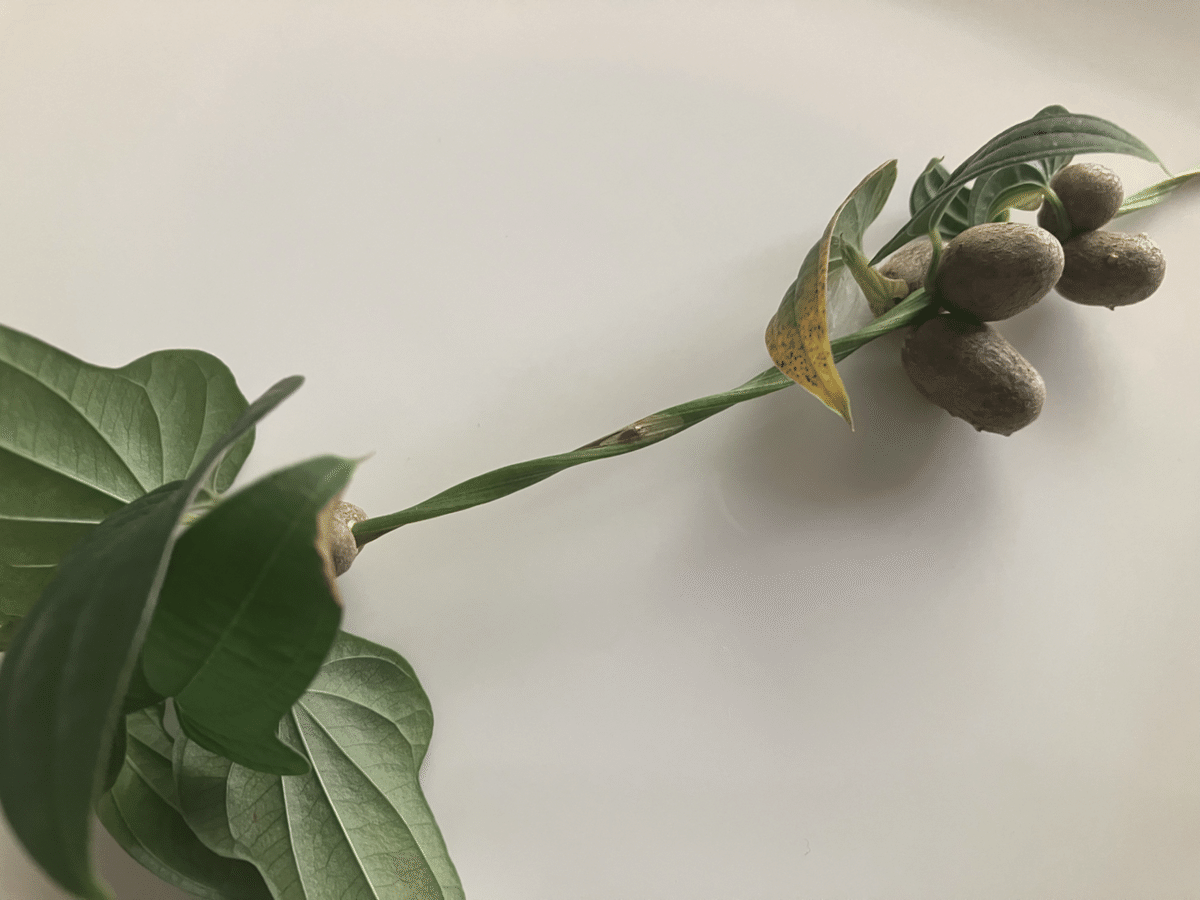
Today's Ingredients:
今日の素材:
米
空き地で収穫したむかご(もちろん市販品でも良い)
昆布
薄口醤油
自然塩
Rice
Kombu (kelp) harvested from a vacant lot (commercially available products are fine)
Light type soy sauce
Natural salt
procedure:
つくり方:
米を吸水させておく。
厚手の鍋に常の通りの分量の水を入れ、昆布を底に敷き、米を入れる。
よく洗ったむかごを入れ、塩でほとんど味を決め、最後に少量に薄口醤油を注ぐ。
ふたをして強火にかける。
沸騰したら、弱火にして十五分ほど炊き込む。
火を止めて、蓋をしたまま十分蒸らす。
米粒を潰さない様に、上下を返し、サービスする。
もちろん、炊飯器を使っても良い。
Leave the rice to absorb the water.
Put the usual amount of water into a thick-bottomed pot, put some kelp on the bottom, and add the rice.
Add well-washed mukago season with salt, and finally add a small amount of light soy sauce.
Cover and bring to a boil, then reduce the heat to low and simmer for around 15 minutes.
Turn the heat off and leave to steam for a while with the lid on.
Turn the rice over, being careful not to crush the grains, and serve.
Of course, you can also use a rice cooker.
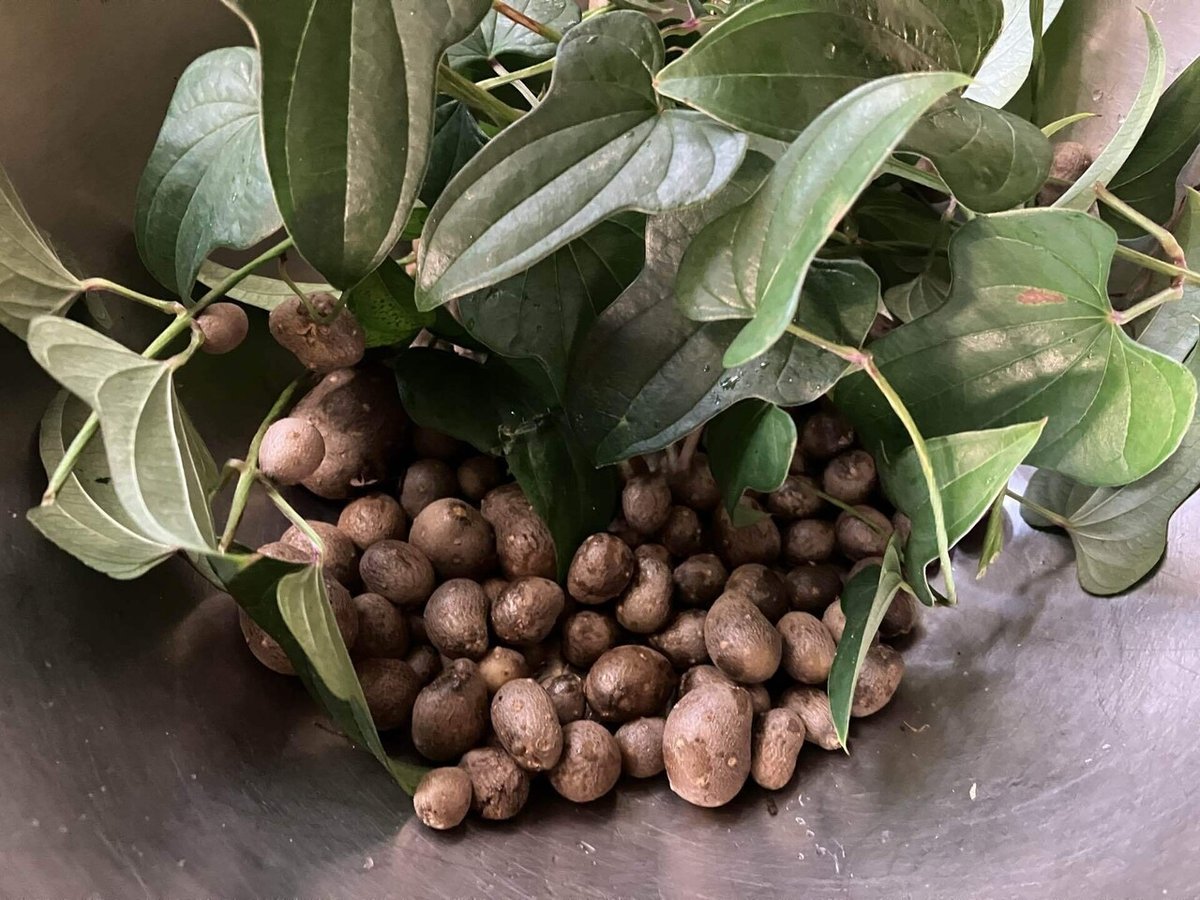
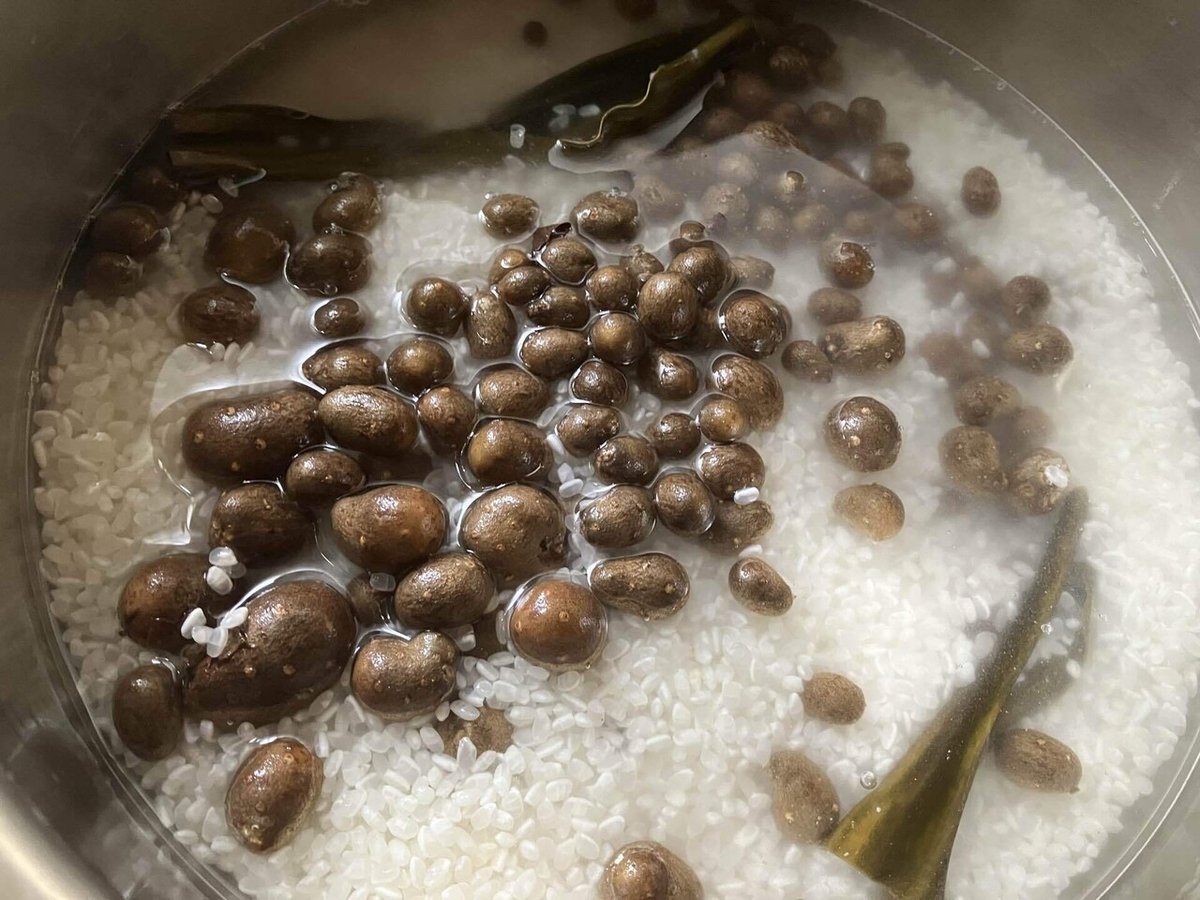
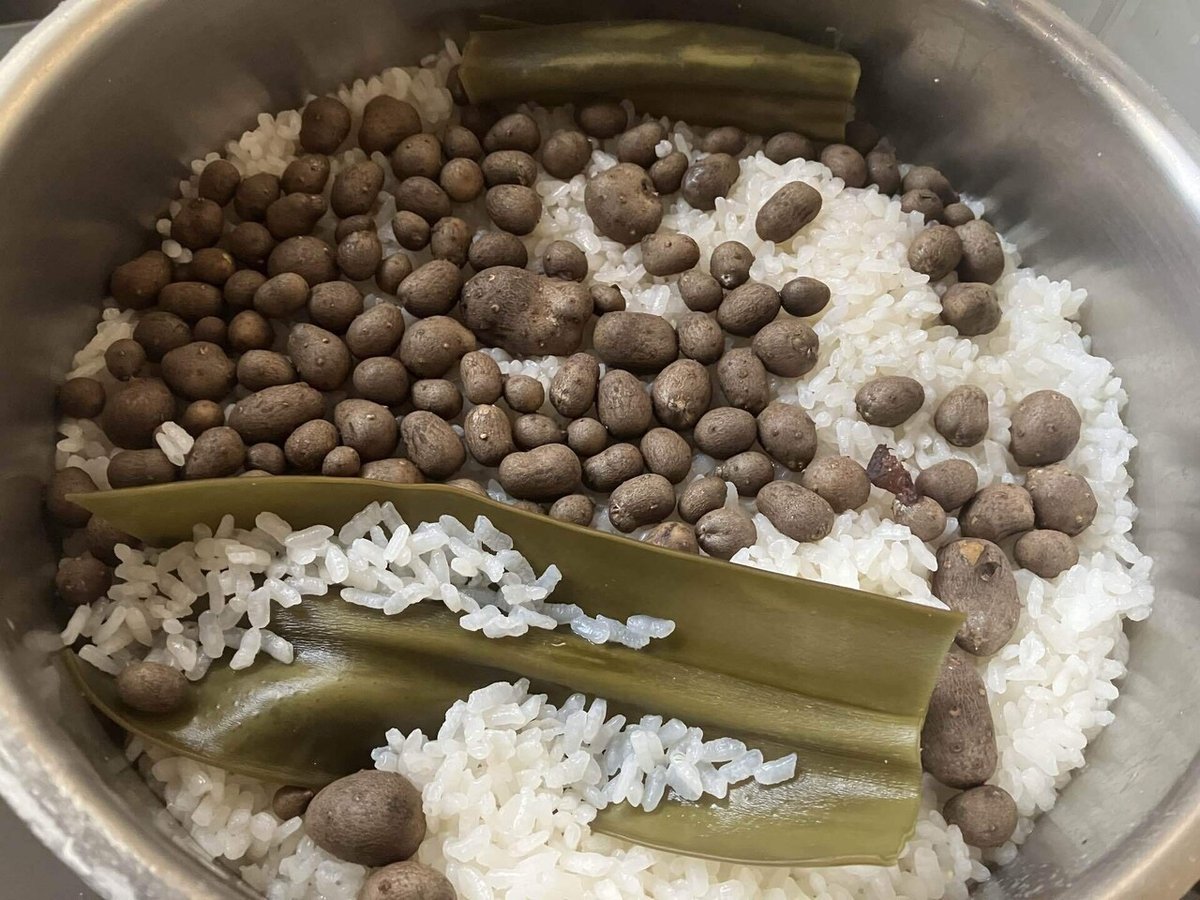
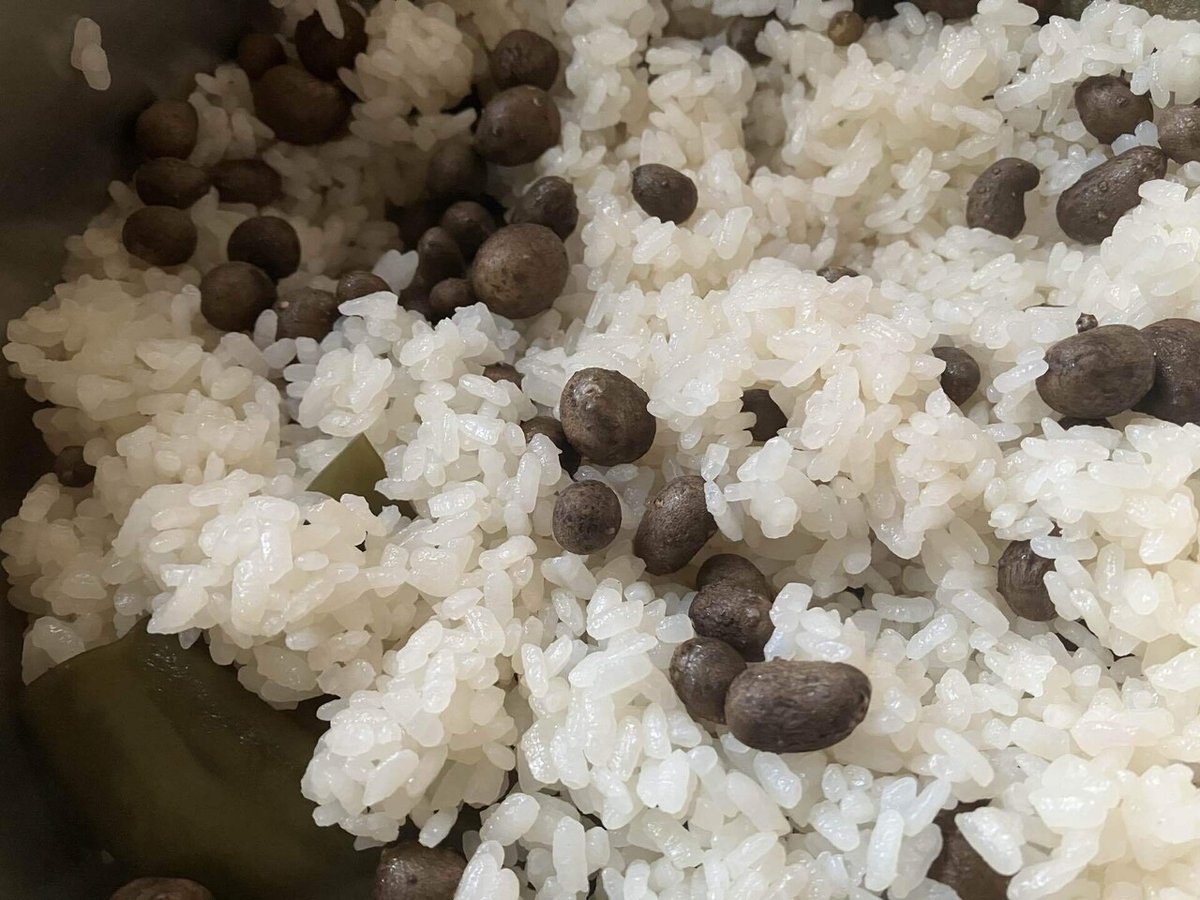
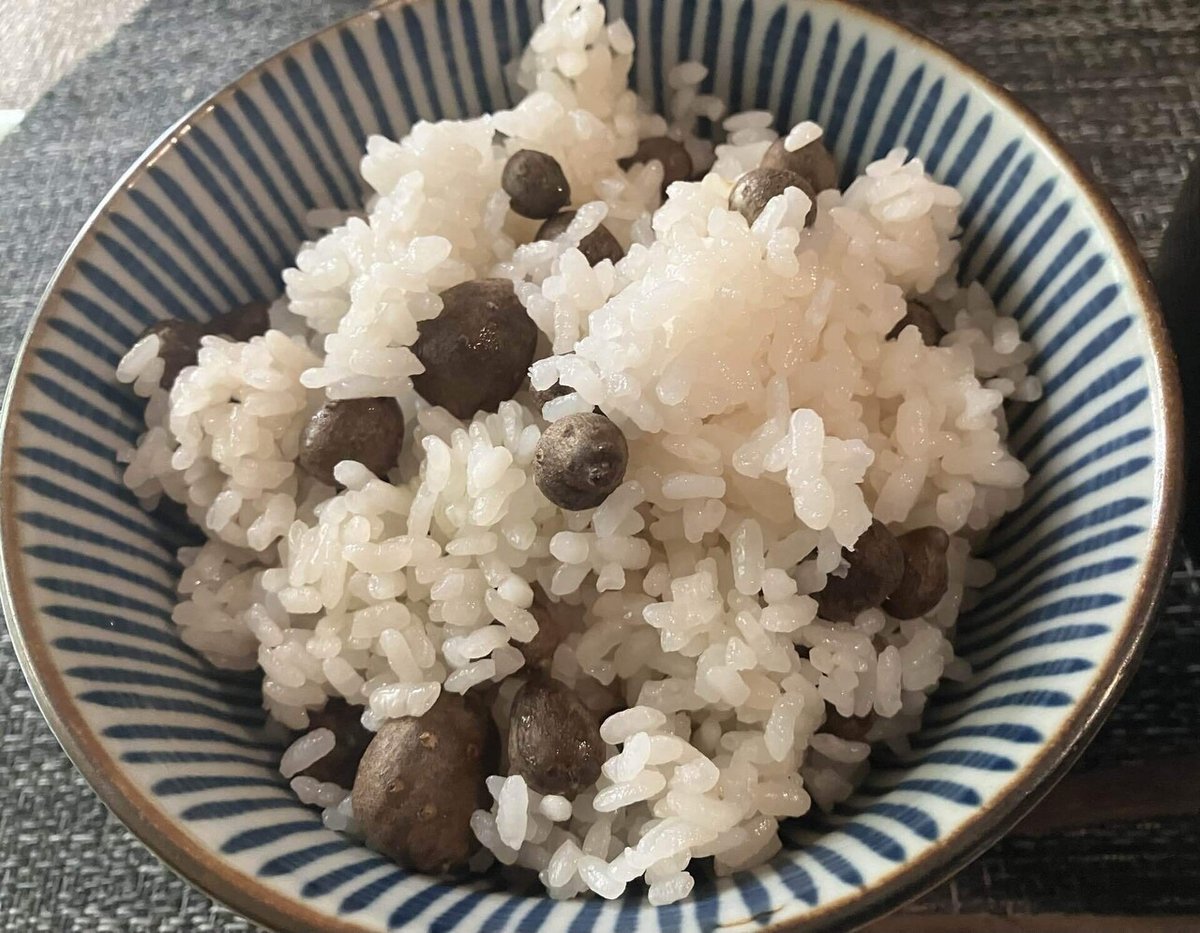
ヒントとバリエーション
Recipe tips and variation
むかごの香りを楽しむ料理なので、生白米を使う。
ここでは鍋で炊き上げているけど、もちろん炊飯器や圧力鍋を使っても良い。鍋は厚手の鍋を使うと美味しく炊き上がる。蓋も重たい方が良い。
昆布と薄口醤油で旨みを補うだけで、余計な味付けは要らない。酒も蛇足。
何かを合わせるなら、お揚げさんなど主張しない素材が良い。
香りが素晴らしいので、余ったらおにぎりにして香りを封じ込めると良い。水を足して雑炊にしても良い。
This dish is meant to enjoy the aroma of mukago, so raw white rice is used.
Here, it is cooked in a pot, but you can of course also use a rice cooker or pressure cooker. The pot will cook best if it is thick-bottomed, and it should have a heavy lid.
No extra seasoning is needed, just add kelp and light soy sauce to add flavour. Sake is also an unnecessary addition.
If you are going to pair it with something, a mild ingredient like fried tofu is best.
The aroma is wonderful, so if you have any left over, make rice balls to seal in the aroma. You can also add more water to make rice porridge.
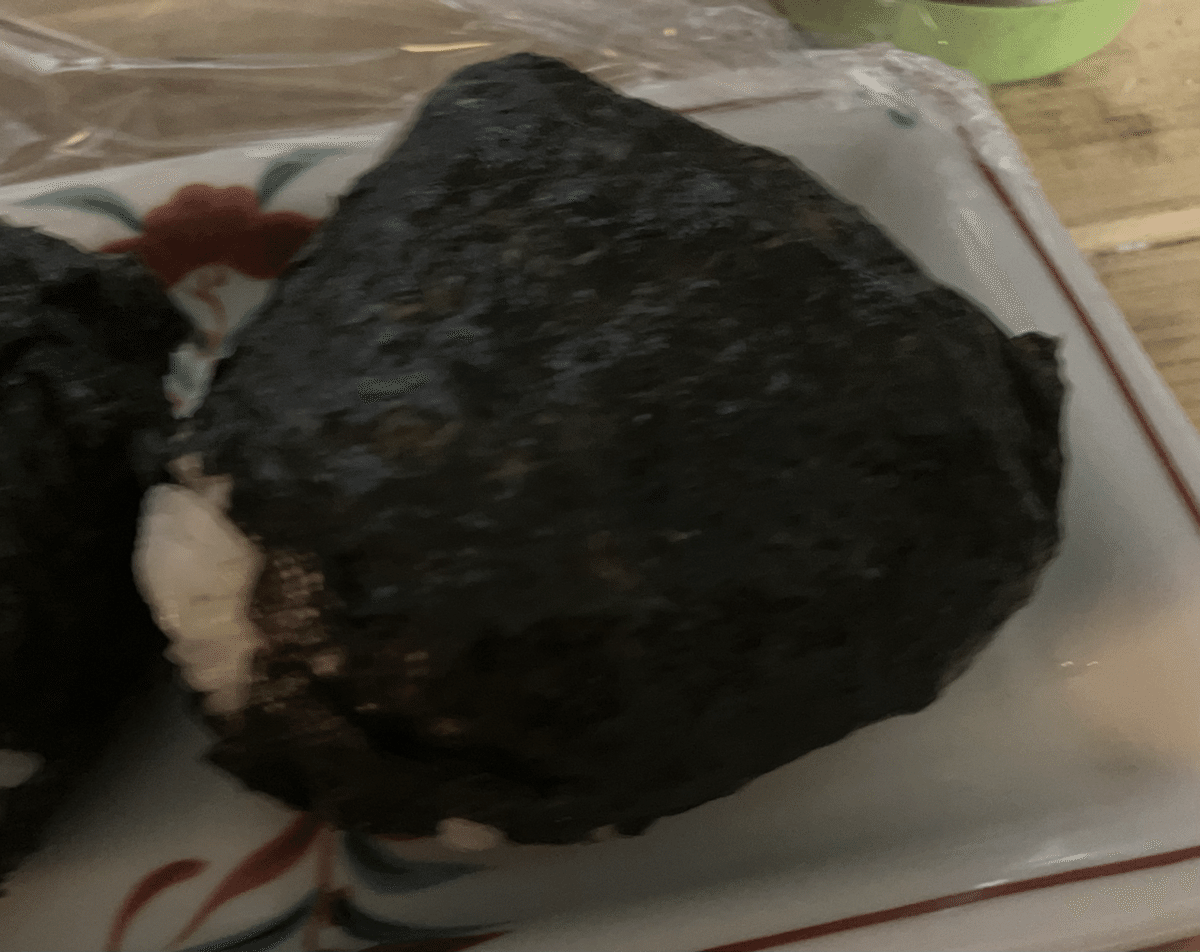
Guide to where to get ingredients and equipment 材料と機材の入手先ガイド
※Amazonのアフェリエイトに参加しています。もしご購入の際はここからクリックしてご購入いただけると、コーヒー代の足しになるので、嬉しいです。ちなみに僕はコーヒー依存症です。
*I participate in Amazon affiliate programs. If you purchase this product by clicking here, it will help pay for my coffee, so I would be very happy. By the way, I am addicted to coffee.
ä
この記事が気に入ったらサポートをしてみませんか?
